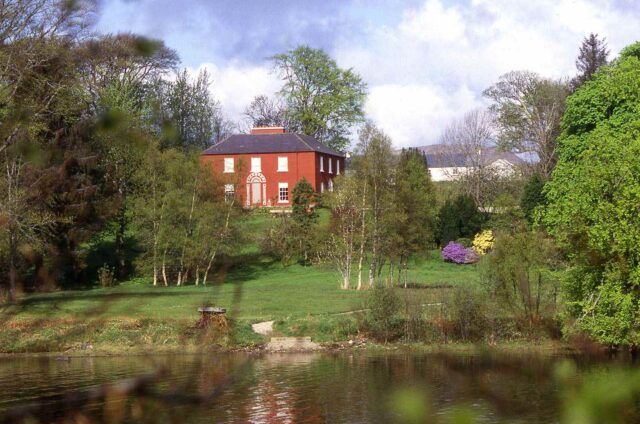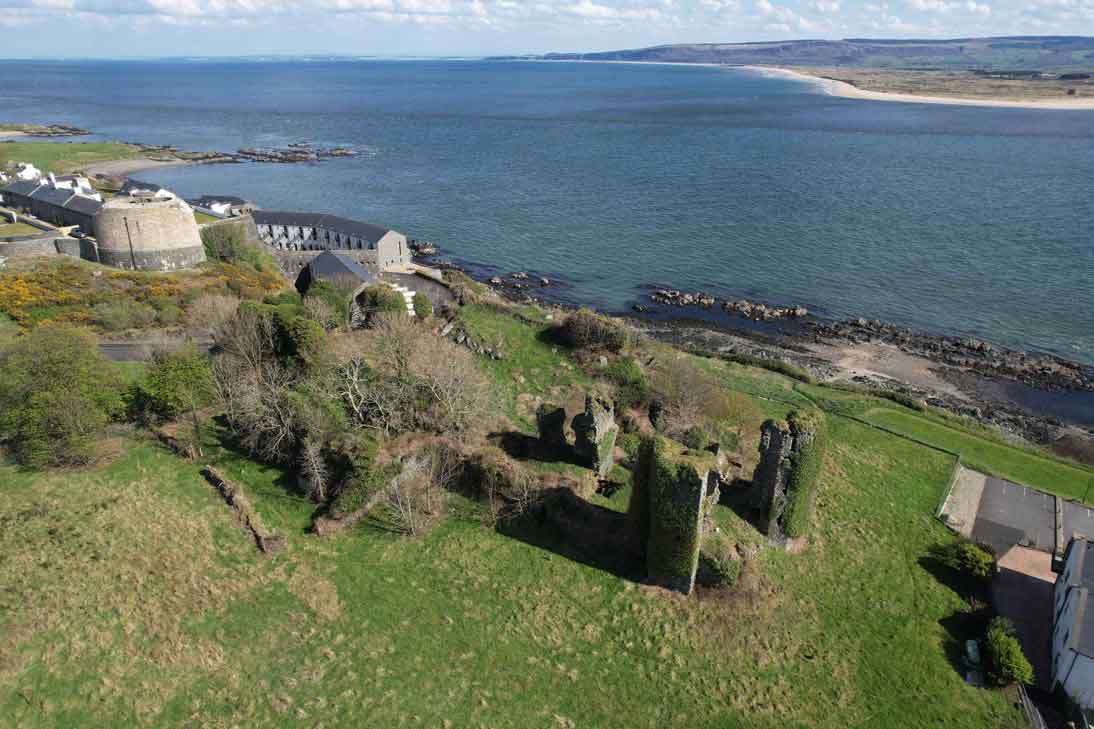Carndonagh, or Carn Domhnach, means ‘The Burial Mound of the Church’.
It is thought that a monastery, or religious establishment, was founded in Carndonagh in 412, by St. Patrick. An entry, to this effect, can be found in the Book of Armagh.
The town nestles in the shadow of the nearby Slieve Sneacht, with the beautiful Trabreaga Bay only a short distance away. Carndonagh is within easy reach of other historic locations on the peninsula, including Malin Head with its historic Malin Well, and Culdaff and Cloncha with its many ancient churches, ring forts and high crosses.
The Carndonagh Cross, on the outskirts of the town, which is thought to date from the 7th century, is one of the oldest and most important free-standing crosses in Ireland. It is decorated with Celtic and Christian symbols and is flanked by two smaller pillar stones which are also of considerable historical interest. The site is a major tourist attraction and it rarely without someone present to enjoy its beauty.
It is thought the Cross is situated on the site of several churches dating back many centuries, and it was one of several crosses that marked the limits of a church boundary – with the Carndonagh Cross being the only one remaining. The Cross was once sited across the road in a nearby field, but it is not known if this was its original position.
It could be speculated that the Cross, or Crosses, could also have been used as markers to guide people across the once boggy land of the plain leading to the nearby coast.
The Cross is an important example of the transition from Christian crosses being carved on slabs, to the stonework being cut into the shape of the cross. The ribbon feature on the face of the Cross indicates the Tree of Life, with figures of birds and eight simple figures shown in low relief further down the Cross. The main figure, with arms outstretched, may represent the crucifixion of Christ. The other figures could represent figures from the crucifixion, such as Mary and Joseph, the two thieves, angels or soldiers, and the holy women visiting the tomb of Jesus.
The two pillar stones, on either side of the Cross, are also decorated with images. One has a figure holding a bell and a book or satchel, possibly a pilgrim, and other images are of a staff, a medieval creature, a head, a face and a fish. The other stone has a harpist (possibly King David), a warrior (possibly Goliath), a fish, a bird and spiral patterns.
The area around Cross, which is beside the main road out of Carndonagh towards Clonmany and Buncrana, was surveyed by the Bernician Studies Group in 2016 and they found evidence of parallel arcs in adjacent fields which suggest the presence of a double circular enclosure around the site. This indicates the location has a place of worship for many centuries. Further evidence of this was recently rediscovered by Colgan Heritage historian, Dessie McCallion, when he found a Bullaun Stone in the wall surrounding the Donagh Church graveyard. Bullaun Stones are usually found on sites with ecclesiastical connections and they may have served as fonts for holy water and date back many centuries.
In the nearby Donagh Church graveyard there is the Marigold Stone, thought to date from the 8th century, and carved lintel stones rescued from an old church on the present site.
The Marigold Stone is carved on all four sides. The west side bears a flabellum with a seven-petalled marigold flower at its head, which may resemble a relic of St. Columcille. There are images of pilgrims on other sides of the Stone. The eastern side of the Stone bears a unique crucifixion scene, with figure of Christ placed so that his head protrudes above the Stone.
The entire site is considered one of the most significant and important early Christian sites in Ireland.
Nearby, there is the site of Leaba Phadraig, where it is thought St. Patrick once rested for the night. Because he rested so peacefully, he took it as a sign from God that he should establish a church nearby.
A short distance from the Cross is the Mass Rock, situated in the local Cnoc Na Coille Daire woods. The Mass Rock was used for the celebration of Mass in Penal Times and the white cross marking the Rock is from a now demolished church in Carndonagh.
Carndonagh of old was an important and thriving Market and Fair Day Town. The design of the town included ‘The Diamond’ at its centre, constructed by George Cary in 1611, to facilitate markets and fairs. The Diamond has been a centre of social and commercial activity for hundreds of years and contains several historic buildings.
Carndonagh has a great many historically important buildings and constructions within its environs and in the nearby countryside, including the Colgan Hall, built in 1914. It was originally a parish hall and school. It is now used as a thriving community centre for the parish and surrounding areas.
The Wesley Hall, built in 1865, was a Methodist church and housed a school in its basement. It is now used by the Carndonagh branch of the Irish Countrywoman’s Association for meetings, to run courses and to house historical items. It is one of the most beautiful structures in the area.
The Tille & Henderson Shirt Factory building is a reminder of the hugely important shirt making tradition in Inishowen. Tille and Henderson was famous for the manufacture of high-quality shirts and pyjamas and this factory was the biggest employer of women in the area, for well over a century, and was vitally important to the local economy.
Thompson’s Bridge is named for John Norris Thompson, who was a Justice of the Peace and he lived in the nearby Bridge Cottage. Thompson kept a diary, and this has provided a wonderful insight into Carndonagh’s past.
The Railway Station House is a reminder of the days of trains in Donegal. Many of these Station Houses remain in use around the peninsula and the House in Carndonagh is surely one of the most beautiful. At one time this was Ireland’s most northerly railway station and it provided services to Derry via Buncrana, and on to the rest of the country. The train arrived at the station in 1901 and the last one left the station in 1935. There was great sadness at the loss of this service, and it was hoped that it might soon return but, alas, it was not to be.
The Inishowen Workhouse and graveyard, which was built in 1844, once occupied the site now used by Carndonagh Hospital. The Workhouse accommodated 6oo people and provided food and shelter for the most needy and destitute of Inishowen. The Workhouse Graveyard can be seen at the entrance of the Hospital grounds. Many of the records and Minute Books from the Workhouse have survived and can be viewed via the Archives Department of the Donegal County Council.
Carndonagh has many beautiful churches from several denominations, and it is the birthplace of the famous friar, theologian and historian, Friar John Colgan, who was born c. 1592. He joined the Franciscan Order and was sent to study in the Irish Franciscan College of St. Anthony of Padua in Leuven in present-day Belgium in 1612. Here he is said to have acted as professor of theology for some time.
While in Carndonagh, why not visit the Barrack Hill, near the Catholic church. You will find beautiful walks with a great variety flora and fauna, a wonderful view of the local countryside, a fully equipped playground for the children and an outdoor gym.
Information is available via the Colgan Heritage Facebook and Twitter pages and you can view thousands of photos and other items on the CarndonaghHeritage.com and Colgan Heritage Weekend websites. The ColganHeritage.com website was launched a few years ago under the direction of archivist, Maura Harkin.
Information is also available at the Colgan Hall in Carndonagh, and at the Tourist Information Office and Traders Association office situated in the Diamond.
Colgan Heritage Committee member, Dr. Sean Beattie, has written many books on the history and heritage of Inishowen and Donegal and produces regular articles on his blog at historyofdonegal.com.
Carndonagh is steeped in history and heritage to explore and if you would like any further information please contact the Colgan Heritage Committee by email at heritagecolgan@gmail.com.









